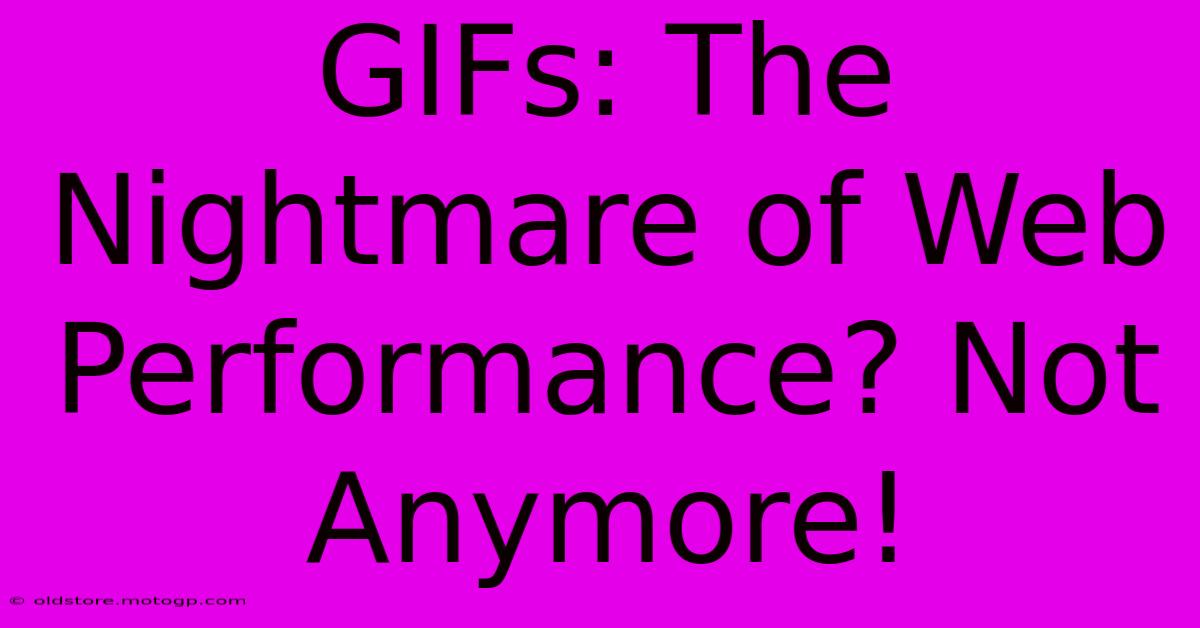GIFs: The Nightmare Of Web Performance? Not Anymore!

Table of Contents
GIFs: The Nightmare of Web Performance? Not Anymore!
GIFs. Those ubiquitous, looping animations that brighten up conversations, explain complex ideas, and add a touch of personality to websites. But for years, they've carried a reputation as web performance villains, notorious for bloating page sizes and slowing down load times. This perception, however, is increasingly outdated. While GIFs can be performance hogs, understanding their strengths and weaknesses, coupled with modern optimization techniques, allows for their effective and efficient use without sacrificing website speed.
The GIF's Historical Performance Problems
Let's face it: the traditional GIF format has its limitations. Its inherent compression method, while effective for its time, often results in larger file sizes than other image formats like JPEGs or WebPs, especially for complex or high-resolution images. This directly impacts website performance: larger files mean longer loading times, leading to frustrated users, higher bounce rates, and ultimately, lower search engine rankings. Google's Core Web Vitals, which heavily emphasizes speed and user experience, penalizes sites with slow loading times.
Why GIFs Were (and Sometimes Still Are) Slow:
- Lack of Compression Efficiency: The older LZW compression algorithm used in GIFs, while functional, is not as efficient as modern codecs.
- Unnecessary Color Palettes: GIFs' reliance on limited color palettes (256 colors maximum) can lead to visual artifacts and larger file sizes if the image requires a broader range of colors.
- Unoptimized Animations: Poorly optimized GIFs, with unnecessary frames or high frame rates, dramatically increase file size without a corresponding improvement in visual quality.
Optimizing GIFs for Superior Performance
The good news is that you don't have to banish GIFs from your website entirely. With a few strategic optimizations, you can leverage their engaging qualities without compromising your site's performance:
1. Choose the Right Format: Consider Alternatives
While GIFs remain popular for their animation capabilities, consider alternatives for static images:
- JPEGs: Ideal for photographs and images with smooth color gradients. Offer excellent compression for photorealistic content.
- WebPs: A modern format offering superior compression compared to both JPEGs and GIFs, supporting both static and animated images. WebP is increasingly supported by modern browsers.
Use GIFs only when animation is essential.
2. Optimize Your GIFs for Size:
- Reduce the Number of Colors: If possible, limit the number of colors used in your GIFs to reduce file size without significant visual loss. Many tools can assist with this.
- Minimize Frames: Reduce the number of frames to the absolute minimum needed to convey the animation smoothly. Unnecessary frames bloat file size.
- Lower the Frame Rate: A higher frame rate (more frames per second) looks smoother, but drastically increases file size. Experiment to find the lowest frame rate that maintains visual quality.
- Use a GIF Optimizer: Several online tools and software programs are specifically designed to compress and optimize GIF files without significant quality loss. These tools can significantly reduce file size.
3. Implement Lazy Loading:
Lazy loading is a technique that delays the loading of images until they are visible within the user's viewport. This prevents unnecessary downloads of images that are far down the page, improving initial load times. This is especially useful when you have multiple GIFs on a page.
4. Use a CDN:
A Content Delivery Network (CDN) distributes your website's content across multiple servers globally, allowing users to access your GIFs from a server closer to their location. This significantly reduces loading times, especially for users who are geographically distant from your web server.
The Future of GIFs and Web Performance
The perceived conflict between GIFs and web performance is largely a legacy issue. By consciously applying optimization techniques, understanding the limitations of the format, and considering alternatives when appropriate, you can harness the visual appeal of GIFs without sacrificing your website's speed and user experience. The future of GIFs on the web is bright, provided we prioritize responsible optimization. The key takeaway? Informed use, not elimination.

Thank you for visiting our website wich cover about GIFs: The Nightmare Of Web Performance? Not Anymore!. We hope the information provided has been useful to you. Feel free to contact us if you have any questions or need further assistance. See you next time and dont miss to bookmark.
Featured Posts
-
Capture Every Moment In Crystal Clarity The V90 Sd Card 128 G For Breathtaking Footage
Feb 04, 2025
-
The Holy Grail Of Nail Gels Why Dnd Gel 268 Is The Top Choice For Nail Professionals
Feb 04, 2025
-
Sssp Royalty A Whos Who Of The Most Influential Ssps
Feb 04, 2025
-
Holy Communion Invitation Revolution Introducing The Collection That Will Make Your Guests Kneel
Feb 04, 2025
-
Unlock The Secrets Of Builder Gel In A Bottle The Salon To Your Fingertips
Feb 04, 2025
